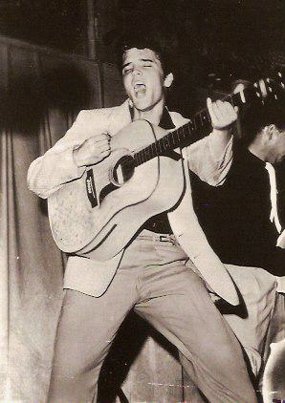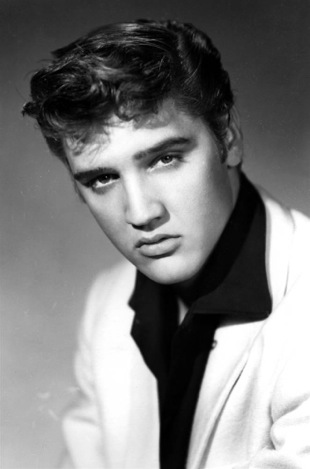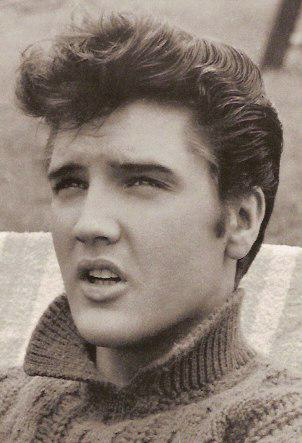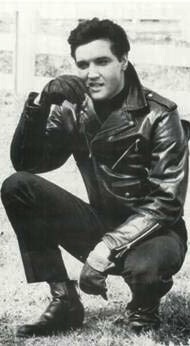Elvis History Blog
Elvis' ’56 Show in Winston-Salem
Amazed Newspaper Reviewer
I received an email message a few months ago from an Elvis fan who had read my book, Elvis ’57: The Final Fifties Tours. She had some very nice things to say about the book, which modesty prohibits me from repeating here. Then she expressed the hope that I would write a similar book about Elvis’ 1956 tours. My response was that, without ruling out the possibility completely, it was very unlikely I would write such a book for two reasons. First, it took me two years to do the research for Elvis ’57, which covers the 18 cities he played that year. In 1956 Elvis performed in 79 cities. That’s a ton of newspaper microfilm to look through. Second, I’m not inclined to put in several years of research on a new Elvis book when I’m still a long ways from making a profit on my first one.

Still, for some time now I have been gathering information about Elvis’ personal appearances during his break out year of 1956. I’m doing it mainly because I’m an Elvis fan, and I enjoy finding new articles about him. Also, it provides me information for use in these weekly blog entries and for other articles on elvis-history-blog.com.
For the 1956 period, I’m using the same primary source I did for the 1957 tours—newspaper archives on microfilm. Obviously, I can’t travel to visit the libraries in all of the 79 cities Elvis played in 1956. What I do is utilize my local library’s inter-library loan program. My library borrows newspaper microfilm from various sources around the country, and that allows me to view it locally.
I’m a linear person, so I started requesting microfilm from the cities Elvis played in January 1956, with the intention of following him through to the end of the year. To this point, I’ve only been able to track Elvis’ personal appearances through the first two months of 1956.
• Kids knew about Elvis in early 1956; the press didn’t
What I’ve learned so far is that during the early part of that year Elvis was still flying under the press’s radar. In local newspapers, there were always advertisements announcing Elvis’ coming appearance. Very rarely, though, did a follow up article about the show itself appear in any of those papers.
While teenagers had tuned into Elvis and excitement was beginning to follow him wherever he went, it was reasonable that newspapers didn’t deem his concerts worthy of coverage at that point. After all, Elvis was just beginning to emerge as a player on the national entertainment scene. His first network TV appearance wasn’t until the end of January on the Dorsey BrothersStage Show program. He sang “Heartbreak Hotel” on the show for the first time on February 11. All four of his Stage Show appearances in January and February 1956 received low ratings compared to Perry Como’s network show in the same time slot. So, it’s understandable that local newspapers were ignoring him in the first two months of 1956.
• North Carolina newspaper one of first to review Elvis in 1956
One of the earliest local newspaper reviews of a 1956 Presley concert appeared in theWinston-Salem Journal on Friday, February 17. The day before Elvis had played three shows at the Carolina Theater in Winston-Salem, N.C. Staff reporter Roy Thompson’s review appeared on page 2 of the Journal.

As to be expected, Elvis’ performance completely blind-sided Thompson. Later in the year, after Elvis had appeared on the Milton Bearle, Steve Allen, and Ed Sullivan shows, local reviewers had an idea of what to expect when Elvis came to town. But in mid-February, Thompson was clearly dumbfounded by what he saw. His review began as follows:
“A most remarkable young man named Elvis Presley came to town yesterday and rocked the staid old Carolina Theater to its very dignified roots. Mr. Presley must be seen if he is to be believed—and even then he seems somewhat unbelievable. He plays (‘beats’ would be a better word) the guitar. He sings (almost any other word would be better there). But, somehow, he wows ’em.”
• Reviewer referred to Elvis' "monumental conceit"
Thompson then attempted to describe in greater detail exactly what he saw and heard.
“Mr. Presley is a part of the new musical phenomenon called ‘Rock ’n Roll.’ He slouches; he mugs; he bumps and grinds. He brings to the stage one of the most monumental conceits seen in these parts in many a day. But he produces, which makes the conceit all right."
(Note: Thompson here is using the term "conceit" in a theatrical sense. It refers to an "artistic device or effect … designed to achieve a particular effect." In other words, Thompson found Elvis's manner of exciting his audience "monumental" in its originality.)
Thompson continued, “Singing such Twentieth Century classics as ‘Blue Suede Shoes’ and ‘Tutti Frutti,’ he sent a matinee houseful of teen-agers and other music-lovers into an orgy of hand-clapping, foot-stamping and tonsil-straining screaming. It is extremely doubtful that the Carolina Theater has ever seen a more enthusiastic audience.”
After leaving the theater, Thompson noticed another element of the growing Presley phenomenon. “And when the show was over,” he wrote, “the long-lonely stage door on North Marshall Street had a cluster of excited youngsters waiting, hoping, praying for a closer look and, perhaps, an autograph from the handsome young man.”
• "Nothing could rival the excitement generated by Elvis"
In his review, Thompson also noted that the other performers in Elvis’ troupe—Justin Tubb, the Louvin Brothers, the Carter Sisters, Benny Martin—“all got applause and whistles enough to satisfy most performers in the spotlight.”
But, Thompson concluded, nothing could rival the excitement generated by Elvis.
“The frenzy, the hysteria, the wild and wonderful shrieks of sheer joy … These were reserved for the remarkable young man with the long hair, the pearly teeth, the stylish slouch, the incredible conceit: Elvis Presley.” — Alan Hanson | © October 2008
Go to Elvis 1956
Go to Home Page

"A most remarkable young man named Elvis Presley came to town yesterday and rocked the staid old Carolina Theater to its very dignified roots. Mr. Presley must be seen if he is to be believed."





